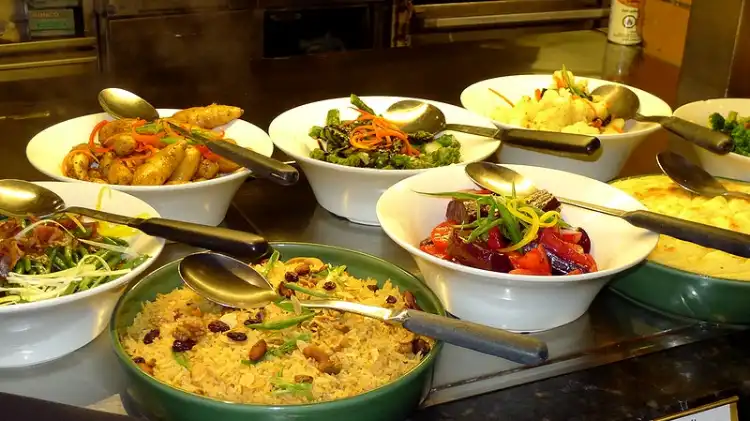Mauritian cuisine is a delightful and mouth-watering fusion of African, Indian, Chinese, and European culinary traditions, reflecting the island’s history and diverse cultural influences. From street food to fine dining, Mauritius offers a rich and diverse gastronomic experience that is not to be missed. In this article, we will explore 15 delicious dishes that make up the vibrant Mauritian food scene.
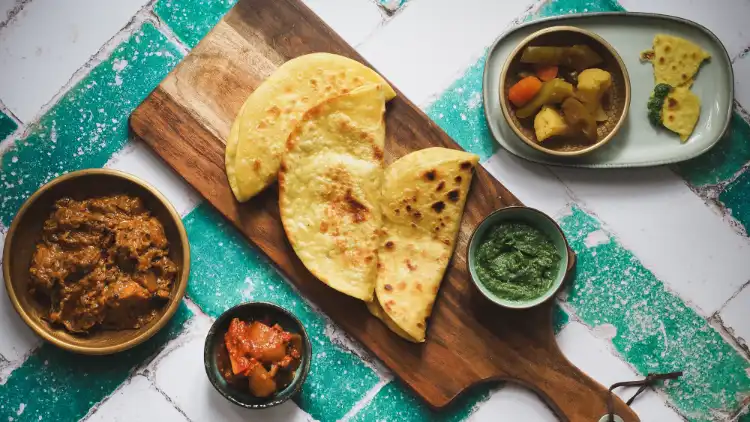
1. Dholl Puri – a lentil flatbread with curries and chutneys
Dholl Puri is a staple food in Mauritius that is loved by locals and visitors alike. This delicious flatbread is made from lentil flour and is typically served with curries and chutneys. Dholl Puri is a popular street food in Mauritius and is often eaten for breakfast or lunch.
History of Dholl Puri
The origins of Dholl Puri can be traced back to India, where it is known as dal puri. It was brought to Mauritius by Indian laborers during the colonial period, and over time, it has become an integral part of Mauritian cuisine. Today, Dholl Puri is considered to be one of the most iconic dishes of Mauritius.
Making Dholl Puri
Dholl Puri is made from a mixture of ground yellow split peas, flour, and spices, including cumin, turmeric, and salt. The mixture is then rolled into small balls and flattened into thin discs. The dough is cooked on a hot tawa or griddle until it is cooked through and slightly crispy on the outside.
Once the Dholl Puri is cooked, it is typically served with a variety of curries and chutneys. Some popular accompaniments include:
Bean Curry – A spicy curry made from kidney beans and flavored with cumin, coriander, and turmeric.
Rougaille – A tomato-based sauce made with onions, garlic, and ginger, spiced with chili and cumin.
Tomato Chutney – A sweet and tangy chutney made from tomatoes, onions, and chili.
Mint Chutney – A refreshing chutney made with fresh mint, coriander, and yogurt.
Variations of Dholl Puri
While the basic recipe for Dholl Puri remains the same, there are some variations that you may find in different parts of Mauritius. For example, some regions may add additional spices such as fennel seeds or ginger to the dough. Some vendors also offer variations with fillings such as grated coconut or chilies.
Where to Find Dholl Puri
Dholl Puri can be found in most parts of Mauritius, from street vendors to fine dining restaurants. It is a popular breakfast and lunch food, and many people enjoy it as a mid-day snack. If you’re looking for an authentic Mauritian food experience, be sure to try Dholl Puri and explore the many different curries and chutneys that accompany it.
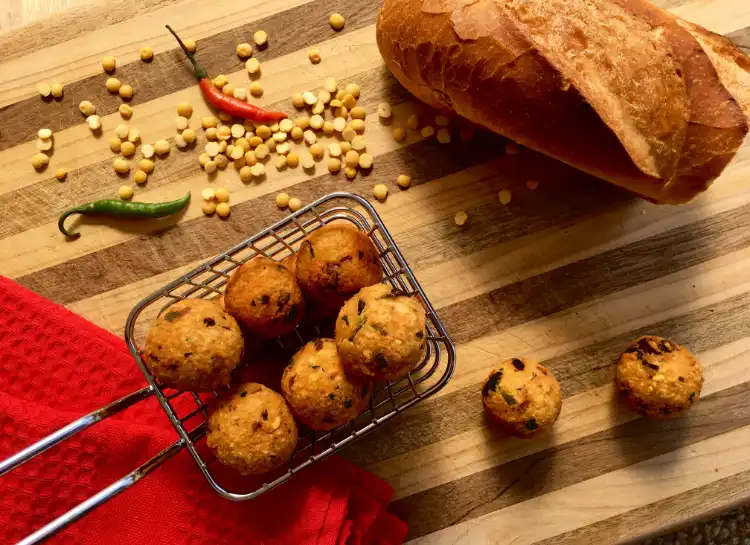
2. Gateaux Piment – chili fritters served with chutney and tomato sauce
Gateaux Piment is a popular snack food in Mauritius that consists of small fritters made from yellow split peas and fresh green chilies. This snack is a quintessential part of the street food scene in Mauritius and can be found at almost every street corner. Gateaux Piment is often served with a variety of chutneys and tomato sauce, and it’s a favorite among locals and tourists alike.
The Origin and History of Gateaux Piment
Gateaux Piment has its roots in the Indian subcontinent, where it is known as “vada.” This snack was brought to Mauritius by Indian immigrants, who arrived on the island during the 19th century. Over time, the recipe was adapted to include the local ingredients and flavors, resulting in the unique and delicious snack that we know today.
Making Gateaux Piment
To make Gateaux Piment, yellow split peas are soaked in water overnight and then ground into a coarse paste. Fresh green chilies, onions, garlic, and coriander are then added to the mixture to give it flavor and spice. The mixture is then shaped into small balls and deep-fried until golden brown.
The final product is a crispy and savory fritter that is bursting with flavor. The heat from the chilies is balanced by the sweetness of the onions, and the coriander adds a fresh and fragrant note to the dish.
Serving Gateaux Piment
Gateaux Piment is typically served hot and fresh, straight out of the fryer. It is often accompanied by a variety of chutneys and tomato sauce, which complement the spiciness of the fritters.
Tamarind chutney, made from tamarind pulp and sugar, is a popular condiment for Gateaux Piment. This sweet and sour chutney provides a nice contrast to the spiciness of the fritters. Mint and coriander chutney, made from fresh herbs and spices, is another popular condiment that is often served with Gateaux Piment.
Tomato sauce, made from fresh tomatoes, onions, and spices, is also a popular accompaniment for Gateaux Piment. This sauce adds a tangy and slightly sweet flavor to the fritters, which complements the heat from the chilies.

3. Fish Vindaye – a tangy and spicy fish curry
Fish Vindaye is a classic Mauritian dish that reflects the island’s Indian and African heritage. It is a tangy and spicy fish curry made with vinegar, mustard seeds, and garlic. This dish is a perfect example of the fusion of cultures and flavors that make up the vibrant Mauritian food scene.
Ingredients:
- 1 lb. firm white fish (such as kingfish, swordfish, or snapper)
- 2 onions, finely chopped
- 2 garlic cloves, minced
- 1-inch piece of ginger, grated
- 1 tbsp. mustard seeds
- 2-3 green chilies, chopped
- 1 tsp. turmeric
- 1 tsp. cumin powder
- 1 tsp. coriander powder
- 1 tbsp. vegetable oil
- 2 tbsp. white wine vinegar
- Salt and pepper to taste
- Fresh coriander leaves, chopped for garnish
Instructions:
- Cut the fish into bite-size pieces and season with salt and pepper.
- In a large bowl, mix together the turmeric, cumin, coriander, and mustard seeds.
- In a pan, heat the oil over medium heat. Add the chopped onions, garlic, and ginger and sauté until the onions are translucent.
- Add the spice mixture to the pan and cook for a few minutes until fragrant.
- Add the chopped green chilies and cook for another minute.
- Add the fish to the pan and stir to coat with the spices. Cook for a few minutes until the fish starts to brown.
- Add the vinegar to the pan and stir to combine.
- Cover the pan and simmer the fish for 5-10 minutes or until the fish is cooked through.
- Serve the Fish Vindaye hot, garnished with chopped coriander leaves.
Fish Vindaye is typically served with rice or flatbread, but it can also be enjoyed on its own. The tangy and spicy flavors of this dish make it a perfect choice for seafood lovers who enjoy a little heat.
One of the great things about Fish Vindaye is its versatility. While it is traditionally made with white fish, you can experiment with different types of seafood, such as shrimp or scallops. Additionally, you can adjust the spice level to your liking by adding more or less green chilies.

4. Boulettes de Poisson – deep-fried fish balls with chili sauce or tomato chutney
Boulettes de Poisson, or fish balls, are a popular street food in Mauritius. Made from a mixture of fish, onion, garlic, and spices, these small balls are deep-fried until crispy on the outside and soft on the inside. They are often served with chili sauce or tomato chutney, making for a delicious and satisfying snack or appetizer.
Origin and History
Boulettes de Poisson has its origins in the Chinese community in Mauritius, where it is known as “yusheng.” The dish was introduced to Mauritius by Chinese immigrants who came to the island in the 19th century to work in the sugarcane fields. Over time, the recipe was adapted to local tastes and ingredients, resulting in the version of Boulettes de Poisson that is enjoyed in Mauritius today.
Preparation and Ingredients
To make Boulettes de Poisson, fish fillets are first cleaned and ground into a fine paste using a food processor or mortar and pestle. The paste is then mixed with finely chopped onions, garlic, ginger, and a variety of spices such as cumin, coriander, and turmeric. The mixture is shaped into small balls and deep-fried until golden brown and crispy.
Chili sauce or tomato chutney is often served with Boulettes de Poisson. Chili sauce is made from a blend of fresh chili peppers, vinegar, and sugar, while tomato chutney is made from chopped tomatoes, onions, garlic, ginger, and a variety of spices such as cumin and coriander. Both sauces add a spicy and tangy kick to the fish balls and complement their crispy texture and savory flavor.
Variations
Boulettes de Poisson can be made with a variety of fish, including red snapper, mackerel, and tuna. The choice of fish will affect the flavor and texture of the fish balls. Some variations of the dish also include additional ingredients such as chopped coriander, breadcrumbs, and eggs to bind the mixture together.
In addition to being served as a street food snack, Boulettes de Poisson can also be enjoyed as a main course, served with rice and a vegetable dish. The dish is also a popular appetizer at Mauritian weddings and other special occasions.
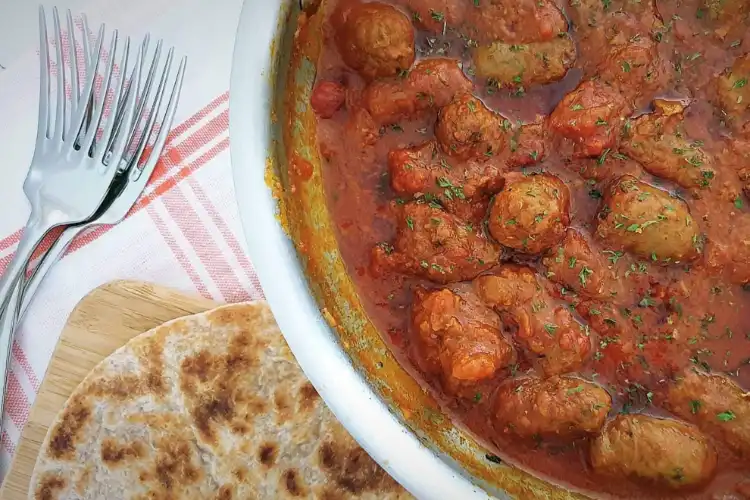
5. Rougaille – a versatile tomato-based sauce served with meats
Rougaille is a versatile tomato-based sauce that is a staple of Mauritian cuisine. The sauce is used to accompany a wide range of meats, including chicken, beef, pork, and fish. Rougaille is a simple and flavorful sauce that is easy to make and can be customized to suit your taste.
The History of Rougaille
Rougaille has its roots in French cuisine, where it is known as “ragoût,” which means stew or ragout. The sauce made its way to Mauritius through French colonization, and it was adapted to suit the island’s tropical ingredients and flavors.
Ingredients and Preparation
The main ingredient in rougaille is tomatoes, which are cooked down to create a thick and flavorful sauce. Other ingredients typically include onions, garlic, ginger, and a variety of spices such as chili, cumin, and coriander.
To make rougaille, the onions, garlic, and ginger are sautéed until soft and fragrant. The tomatoes are then added and cooked down until they break down and form a thick sauce. The spices are added, and the sauce is left to simmer for several minutes to allow the flavors to meld together.
Variations of Rougaille
There are many variations of rougaille, and each cook puts their own spin on the dish. Some cooks add a splash of vinegar or lime juice to the sauce to give it a tangy kick, while others add coconut milk to make it creamier.
Rougaille can also be customized to suit different meats. For example, when served with chicken, the sauce can be made spicier with extra chili, or sweeter with a touch of honey. When served with fish, the sauce can be lightened with a bit of lemon juice, or made more aromatic with the addition of fresh herbs like thyme or basil.
Serving Rougaille
Rougaille is a versatile sauce that can be served with a wide range of meats. It is typically served over a bed of rice or with a side of bread to soak up the flavorful sauce. Rougaille is a popular dish at Mauritian festivals and celebrations, where it is often served with grilled or roasted meats.
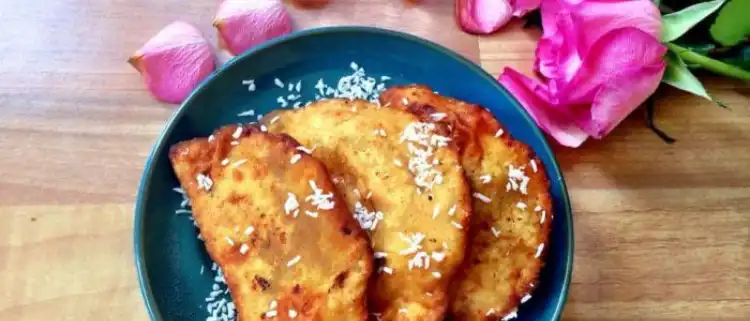
6. Gateau Patate – sweet potato cake with cinnamon and nutmeg
Gateau Patate is a traditional sweet potato cake that is popular in Mauritius. It is a dessert that is enjoyed by locals and visitors alike, with its unique blend of flavors and textures. The cake is made from mashed sweet potatoes, coconut milk, and a combination of spices, such as cinnamon and nutmeg. This article will delve into the origins, ingredients, and preparation of Gateau Patate, as well as some tips for making this delicious dessert.
Origins
Mauritian cuisine is a blend of various cultural influences, including African, Indian, Chinese, and European. Gateau Patate is believed to have originated in Mauritius during the colonial period. The dish reflects the island’s multicultural heritage and the creative ways in which different culinary traditions were combined.
Ingredients
The main ingredient in Gateau Patate is sweet potatoes, which are abundant in Mauritius. The sweet potatoes are boiled, mashed, and mixed with coconut milk, sugar, and spices. Cinnamon and nutmeg are the most commonly used spices, but other flavors can be added, such as vanilla or cardamom.
Preparation
To make Gateau Patate, the sweet potatoes are first peeled and boiled until they are soft. They are then mashed and mixed with sugar, coconut milk, and spices. The mixture is then poured into a baking dish and baked in the oven until it is soft and slightly crispy on the outside. Some recipes also call for adding eggs or flour to the mixture, which gives the cake a more cake-like texture.
Tips for Making Gateau Patate
Here are a few tips for making the perfect Gateau Patate:
- Use fresh sweet potatoes. Make sure that the sweet potatoes are fresh and not overripe, as this can affect the taste and texture of the cake.
- Get the spice blend right. The key to a delicious Gateau Patate is the combination of spices. Cinnamon and nutmeg are the most commonly used spices, but other flavors can be added to suit your tastes.
- Don’t overmix the batter. Overmixing the batter can lead to a tough and dense cake. Mix the ingredients until they are just combined.
- Bake at the right temperature. The cake should be baked at a moderate temperature, around 350 degrees Fahrenheit, for about 30-40 minutes.

7. Octopus Salad – boiled octopus with fresh herbs, lemon juice, and olive oil
Octopus Salad is a delightful and refreshing seafood dish that is a popular feature on menus in Mauritius. It is a light and healthy dish that is perfect for hot summer days or as a refreshing appetizer or side dish.
The dish is made by boiling the octopus in water until it is tender and then mixing it with a variety of fresh herbs, lemon juice, and olive oil. The result is a tangy and zesty dish that is full of flavor and texture.
Octopus is a common ingredient in Mauritian cuisine, and it is often used in a variety of dishes, including curries, stews, and salads. It is a nutritious and delicious seafood that is high in protein and low in fat, making it a healthy choice for those looking for a balanced diet.
To prepare Octopus Salad, the octopus is first cleaned and rinsed thoroughly. It is then boiled in water for about an hour until it is tender. The boiled octopus is then cut into small pieces and mixed with a variety of fresh herbs, such as parsley, coriander, and basil, as well as some finely chopped onions and garlic.
The dressing for the salad is made by mixing olive oil, lemon juice, salt, and pepper together in a bowl. The dressing is then poured over the octopus and herb mixture, and the salad is tossed well to ensure that all the ingredients are well coated with the dressing.
The resulting dish is a refreshing and tangy seafood salad that is perfect for any occasion. The fresh herbs and zesty dressing give the octopus a burst of flavor, while the tender meat provides a satisfying texture.
Octopus Salad is often served as an appetizer or side dish in Mauritian cuisine, and it pairs well with a variety of other seafood dishes or light and refreshing salads. It is also a great dish to serve at a summer barbecue or outdoor picnic, as it is easy to prepare and transport.
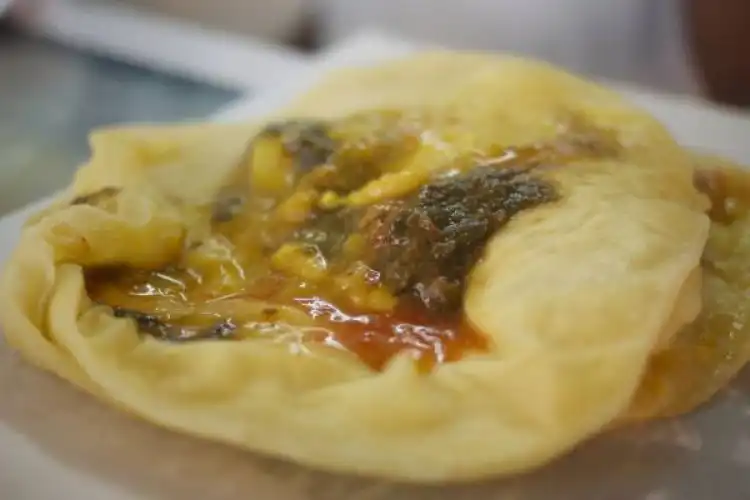
8. Dal Puri – lentil stuffed bread, a popular street food
Dal Puri is a popular street food in Mauritius that consists of a thin, flatbread stuffed with a mixture of seasoned ground split peas, onions, and other herbs and spices. It is a versatile dish that can be enjoyed at any time of day, either on its own or with a variety of accompaniments.
History and Origins
The origins of Dal Puri can be traced back to the Indian subcontinent, where a similar dish called Dal Paratha is popular. The dish was brought to Mauritius by Indian indentured laborers in the 19th century. Over time, the recipe has been adapted and modified to include local flavors and ingredients.
Preparation and Cooking
The dough for the Dal Puri is made from flour, water, and oil. The filling is a mixture of cooked and mashed split peas, onions, garlic, and a blend of spices such as cumin, coriander, and turmeric. The filling is then placed in the center of a small portion of the dough, and the dough is wrapped around the filling to form a ball. The ball is then rolled out into a thin, flatbread, usually about 10 inches in diameter.
The Dal Puri is then cooked on a hot tawa, a flat iron griddle, until it is golden brown on both sides. The finished product is a delicious and aromatic flatbread with a crispy exterior and a soft, flavorful filling.
Serving Suggestions
Dal Puri is often served on its own as a snack or light meal. It can also be served with a variety of accompaniments, such as chutney, pickles, and a side of vegetable curry or daal. Many people in Mauritius also enjoy dipping the Dal Puri in tea or coffee for a quick and satisfying breakfast.
Variations
In addition to the traditional recipe, there are several variations of Dal Puri that can be found in Mauritius. Some recipes use different types of lentils, such as yellow split peas or chickpeas, in the filling. Others incorporate local flavors, such as grated coconut or fresh herbs, to add an extra burst of flavor.
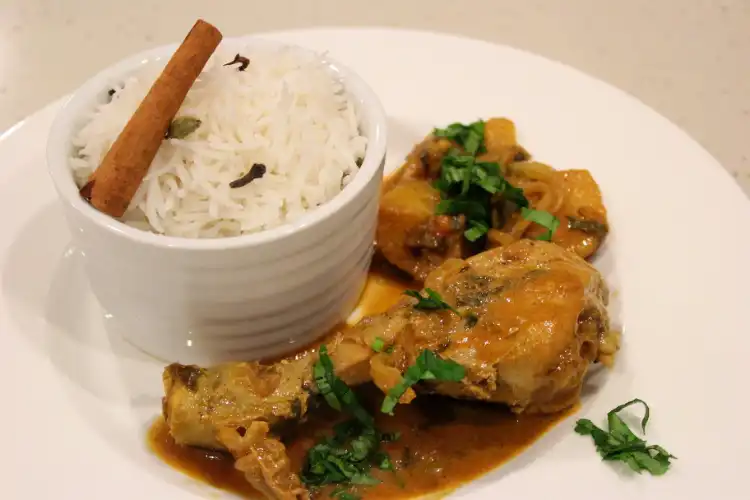
9. Chicken Kalia – a spicy chicken curry often served at special occasions
Chicken Kalia is a delicious and spicy chicken curry that is a popular dish in Mauritius. It is often served at special occasions such as weddings, festivals, and family gatherings. Chicken Kalia is a flavorful and aromatic dish that is made with a blend of spices and herbs, giving it a unique and distinct taste that is loved by many.
The key to making a great Chicken Kalia is in the spice blend. A typical spice blend for this dish would include cumin, coriander, turmeric, and chili powder. The spices are mixed with ginger, garlic, and onions to create a fragrant base for the chicken. The chicken is then added to the mixture and left to cook, allowing the flavors to meld together.
One of the unique features of Chicken Kalia is the addition of yogurt or cream towards the end of the cooking process. This helps to thicken the sauce and give it a creamy texture, while also providing a slight tanginess to the dish. The chicken is cooked until it is tender and falls off the bone, and the sauce is reduced to a rich and flavorful consistency.
Chicken Kalia can be served with a variety of sides, such as rice, roti, or naan bread. It is also often paired with other dishes such as dal, raita, and chutneys to create a well-rounded and balanced meal. The dish can be made with boneless chicken or with bone-in pieces, depending on personal preference.
The history of Chicken Kalia can be traced back to the Indian subcontinent, where it is a popular dish in many regions. The dish has been adapted and modified in Mauritius to reflect the island’s unique blend of cultural influences. It is now a staple dish in Mauritian cuisine and is enjoyed by locals and visitors alike.
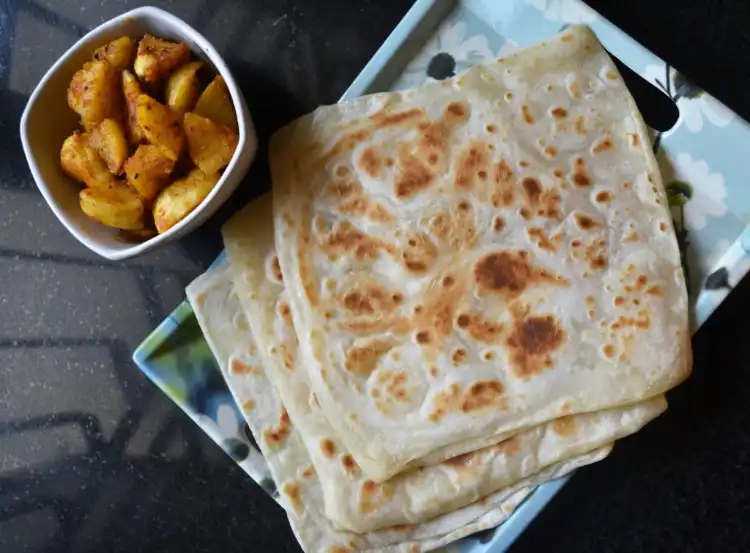
10. Farata – a soft and fluffy flatbread, similar to Indian parathas
Farata is a soft and fluffy flatbread that is a staple in Mauritian cuisine. This delicious bread is similar to Indian parathas, and it’s often served with curries, pickles, and chutneys. In this article, we’ll explore the history, preparation, and uses of Farata in Mauritian cuisine.
History of Farata
Farata, also known as “paratha” in India, has a long and rich history. The bread is thought to have originated in the Indian subcontinent and was brought to Mauritius by Indian laborers during the 19th century. Farata has since become a beloved dish in Mauritian cuisine and is now considered a staple food on the island.
Preparation of Farata
Farata is made from a simple dough that consists of flour, water, and salt. The dough is kneaded until it is smooth and elastic and then divided into small balls. Each ball is rolled out into a thin circle and then brushed with oil or ghee. The circle is then folded in half, and the edges are sealed. The folded circle is then rolled out again to create a thin, layered bread.
The bread is then cooked on a hot griddle or tawa until it is golden brown and crispy. The bread is flipped over a few times during cooking to ensure that it cooks evenly. The result is a soft and fluffy flatbread with delicious layers of flavor.
Uses of Farata
Farata is a versatile bread that can be used in many different ways in Mauritian cuisine. It is often served with curries, stews, and other dishes that have a lot of sauce. The bread can be used to scoop up the sauce and soak up all the flavors.
Farata is also commonly used as a wrap for sandwiches and other fillings. It can be filled with meat, vegetables, or chutneys, making it a popular snack or lunch option. Farata is often eaten on its own as well, as a delicious and satisfying bread.
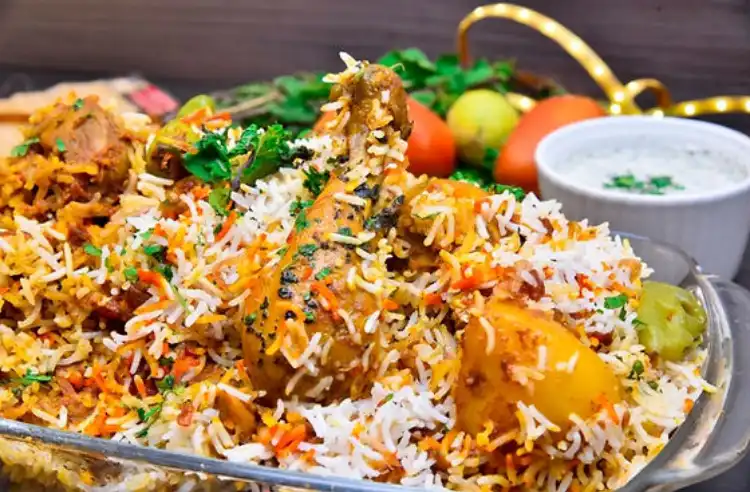
11. Briyani – a flavorful rice dish with meat or vegetables
Briyani is a flavorful rice dish that is a popular and beloved staple in Mauritian cuisine. It is a savory and aromatic dish that combines spiced rice with meat or vegetables, creating a mouthwatering fusion of flavors and textures. Briyani has a rich history and cultural significance, reflecting the influences of the Indian and Muslim communities in Mauritius. In this article, we will explore the history, ingredients, and cooking methods of this beloved dish.
History of Briyani
Briyani is believed to have originated in Persia and was introduced to the Indian subcontinent during the Mughal Empire. The dish was further developed in India and evolved into many regional variations. The word “biryani” comes from the Persian word “birian,” which means “fried before cooking.” Over time, biryani was adapted and modified to suit local tastes and ingredients, resulting in the many different styles of biryani found in various regions of the world.
In Mauritius, briyani is a popular dish that has been influenced by the island’s Indian and Muslim communities. It is often served at weddings, festivals, and other special occasions, and it is a dish that is enjoyed by people from all walks of life.
Ingredients of Briyani
The main ingredients in briyani are rice, meat or vegetables, and a complex blend of spices. The rice used in briyani is often long-grain basmati rice, which is fragrant and flavorful. The meat used can be chicken, lamb, beef, or goat, and the vegetables can include potatoes, peas, carrots, and cauliflower. The spices used in briyani can vary, but they often include cinnamon, cardamom, cumin, coriander, and turmeric. Other ingredients that are often used in briyani include onions, garlic, ginger, and tomato.
Cooking Methods of Briyani
There are many different methods of cooking briyani, but the most common method is the dum style. In this method, the meat or vegetables are cooked separately from the rice, and then the two are layered in a pot and steamed together. This allows the flavors to meld and infuse the rice with the spices and juices from the meat or vegetables.
To make briyani, the first step is to prepare the meat or vegetables. The meat is often marinated in a mixture of yogurt and spices, while the vegetables are sautéed with onions and spices. The rice is then rinsed and soaked to remove excess starch, which helps to prevent it from becoming mushy during cooking. The rice is then partially cooked in a pot of boiling water before being drained and layered with the meat or vegetables in a large pot.
The pot is then sealed with a tight-fitting lid and placed over low heat, allowing the briyani to cook slowly and evenly. The steam from the cooking meat or vegetables rises and infuses the rice with flavor, resulting in a fragrant and flavorful dish. The dish is then served hot, often garnished with fried onions, fresh herbs, and a side of raita, a yogurt-based condiment.

12. Napolitaine – a sweet pastry filled with jam and cream
Napolitaine is a beloved pastry in Mauritius, known for its crispy layers and rich filling of jam and cream. It is a popular dessert served in bakeries, cafes, and homes throughout the island, and is a must-try for anyone visiting Mauritius.
The pastry is typically made with layers of flaky puff pastry, which is made by rolling and folding dough multiple times to create dozens of delicate layers. The result is a pastry that is light and airy, yet incredibly crispy and buttery.
The filling is what truly sets Napolitaine apart, and is the source of its irresistible sweetness. The most common filling is a combination of jam and cream, usually strawberry jam and whipped cream, but other types of fruit jams and flavored creams are also used.
To make Napolitaine, the puff pastry is cut into rectangles or squares and baked until golden brown and crispy. The pastry is then split in half, and a layer of jam and cream is added to one half before being sandwiched with the other half. The top of the pastry is often dusted with powdered sugar for an extra touch of sweetness.
Napolitaine is often served as a dessert, but it can also be enjoyed as a snack or breakfast pastry. It is a versatile treat that can be eaten on its own or paired with coffee or tea.
While Napolitaine is a beloved pastry in Mauritius, it actually has Italian origins. The pastry is believed to have originated in Naples, Italy, where it is known as sfogliatella. The pastry made its way to Mauritius through French and British colonial influences, and has since become a favorite of the island’s diverse population.
In recent years, there has been a growing trend of bakeries and cafes in Mauritius experimenting with new flavors and fillings for Napolitaine. Some variations include chocolate cream, passion fruit jam, and even savory fillings like ham and cheese.

13. Bol Renversé – an upside-down bowl of rice, meat, and vegetables
Bol Renversé, or “upside-down bowl,” is a popular dish in Mauritius that is known for its unique presentation and delicious flavor. This hearty meal consists of a bowl of rice, topped with a layer of meat and vegetables, and then turned upside down onto a plate. In this article, we will explore the history and ingredients of Bol Renversé and explain how to make this classic Mauritian dish.
History and Origins
Bol Renversé is believed to have originated in Reunion Island, a French overseas territory located near Mauritius. The dish was inspired by a popular Chinese rice bowl, which was turned upside down to mix the ingredients together. Bol Renversé was introduced to Mauritius by French settlers in the 18th century and has since become a beloved staple of Mauritian cuisine.
Ingredients
Bol Renversé is a versatile dish that can be made with a variety of ingredients, but the basic components typically include:
- Rice – The foundation of the dish, which can be flavored with herbs, spices, or coconut milk.
- Meat – A protein source such as beef, chicken, or pork, which is cooked with onions, garlic, and other spices.
- Vegetables – A variety of vegetables such as carrots, peas, and green beans, which are sautéed with the meat.
- Egg – A fried or boiled egg, which is placed on top of the meat and vegetables before the dish is flipped.
- Sauce – A flavorful sauce such as tomato, soy, or oyster sauce, which is poured over the meat and vegetables.
Preparation
To make Bol Renversé, start by cooking the rice in a pot with water or coconut milk until it is tender and fluffy. While the rice is cooking, sauté the meat and vegetables in a separate pan with onions, garlic, and other spices until they are tender and well-seasoned. Once the meat and vegetables are cooked, set them aside and fry or boil an egg to place on top of the meat and vegetables.
To assemble the dish, place a serving of rice in a bowl, then add a layer of meat and vegetables on top. Place the egg on top of the meat and vegetables and pour the sauce over the entire dish. Finally, flip the bowl upside down onto a plate, allowing the rice, meat, vegetables, and egg to spill out onto the plate in a beautiful and unique presentation.
Variations
Bol Renversé can be customized to suit individual tastes and preferences. Some variations include:
- Seafood – A seafood version can be made using shrimp, calamari, or other seafood instead of meat.
- Vegetarian – A vegetarian version can be made by omitting the meat and using tofu or tempeh instead.
- Fusion – A fusion version can be made by adding elements of other cuisines, such as curry or teriyaki sauce.
Bol Renversé is a delicious and unique dish that has become a beloved staple of Mauritian cuisine. With its flavorful combination of rice, meat, vegetables, and sauce, it’s no wonder that this dish has become a favorite of locals and tourists alike. Whether you’re enjoying it at a restaurant or making it at home, Bol Renversé is sure to delight your taste buds and satisfy your hunger.
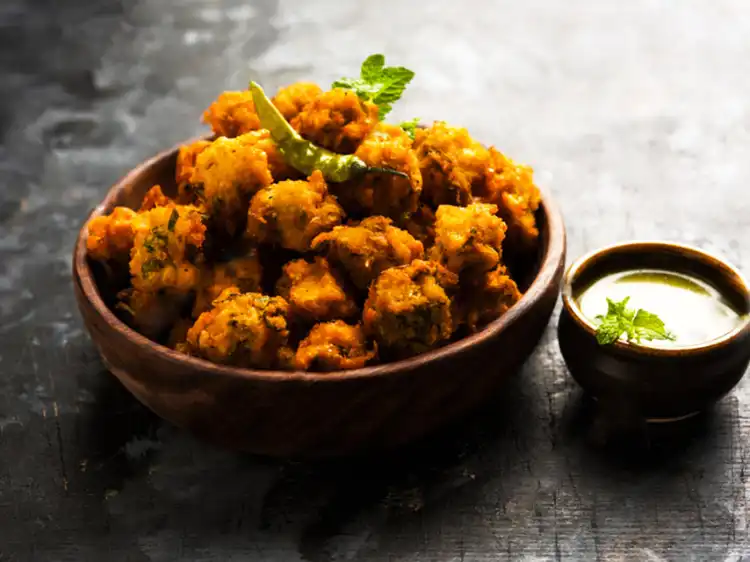
14. Gateau Piments – a savory snack made from yellow split peas and spices
Gateau Piments is a delicious and savory snack that is a popular street food in Mauritius. Made from yellow split peas and spices, this snack is loved by locals and tourists alike. In this article, we will explore the history and preparation of Gateau Piments, as well as the flavors and textures that make it a beloved Mauritian dish.
History and Origin of Gateau Piments
Gateau Piments has its roots in Indian cuisine, reflecting the influence of Indian migrants who settled in Mauritius in the 19th century. The dish is said to have originated in the northern part of the island, where it quickly became a favorite street food.
The name “Gateau Piments” translates to “chili cakes,” and this snack is certainly spicy. The yellow split peas are blended with fresh herbs and spices, including cumin, coriander, and turmeric, to create a flavorful and aromatic snack that is perfect for those who love a bit of heat in their food.
Preparation of Gateau Piments
To make Gateau Piments, yellow split peas are soaked in water overnight and then drained. The peas are then blended with onions, garlic, fresh herbs, and a blend of spices until a smooth paste is formed. This paste is then shaped into small balls and deep-fried until golden brown and crispy.
The result is a delicious and flavorful snack that is crispy on the outside and soft on the inside. Gateau Piments is often served with a variety of sauces, including tomato sauce, chili sauce, and tamarind sauce, which complement the savory flavors of the snack.
Flavors and Textures of Gateau Piments
Gateau Piments is known for its unique blend of flavors and textures. The yellow split peas give the snack a soft and creamy texture, while the deep-frying process creates a crispy outer layer that adds a satisfying crunch. The combination of spices and fresh herbs gives Gateau Piments a complex and aromatic flavor profile that is both savory and slightly spicy.
This snack is often enjoyed as a mid-morning or mid-afternoon snack and is a favorite among locals and tourists alike. It is also a popular party food and can be found at weddings, festivals, and other celebrations.
Gateau Piments is a must-try snack for anyone visiting Mauritius. This savory and spicy snack is a testament to the island’s rich and diverse culinary heritage, blending Indian and African flavors to create a unique and delicious dish. Whether enjoyed on the go or as part of a larger meal, Gateau Piments is a perfect example of the vibrant and flavorful Mauritian food scene.
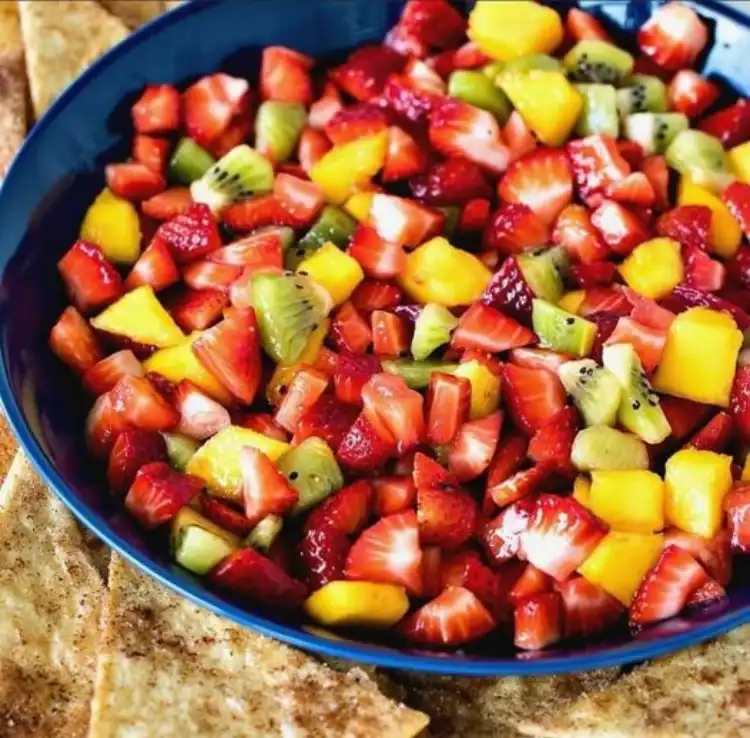
15. Fruit Salad – a refreshing mix of tropical fruits such as pineapple, mango, and papaya
Fruit salad is a refreshing and healthy dish that is perfect for any occasion, whether it’s a summer picnic, a family gathering, or a light dessert after a meal. In Mauritius, fruit salad is a popular dish, and it often includes a mix of tropical fruits such as pineapple, mango, and papaya.
Pineapple is one of the most popular fruits in Mauritius, and it is often the base of a fruit salad. It is sweet and juicy with a slightly tangy flavor that pairs well with other tropical fruits. Pineapple is also rich in vitamin C, which helps to boost the immune system and promote healthy skin.
Mango is another tropical fruit that is often included in a Mauritian fruit salad. It is sweet and juicy, with a rich and creamy texture that adds depth and flavor to the dish. Mango is also a good source of vitamin A, which is essential for maintaining healthy eyesight.
Papaya is a nutritious fruit that is also commonly used in Mauritian fruit salads. It is sweet and refreshing with a unique flavor that adds complexity to the dish. Papaya is rich in vitamins C and E, as well as folate, which are all essential for maintaining good health.
In addition to these three main fruits, Mauritian fruit salad may also include other tropical fruits such as banana, guava, passion fruit, and lychee. Each of these fruits brings its own unique flavor and texture to the dish, creating a delicious and satisfying blend of tastes.
To make a Mauritian fruit salad, the fruits are first peeled and chopped into bite-sized pieces. They are then mixed together in a bowl and tossed with a light syrup made from sugar and water. Some recipes may also include a squeeze of lime or lemon juice to add a tangy flavor to the dish.
Fruit salad is not only delicious but also a healthy dish that is low in calories and high in nutrients. It is an excellent source of fiber, vitamins, and antioxidants, all of which are essential for maintaining good health. Eating fruit salad regularly can help to boost the immune system, reduce inflammation, and promote healthy digestion.
A Mauritian fruit salad is a delightful and refreshing dish that is perfect for any occasion. It is a great way to enjoy the delicious and healthy fruits that are abundant in the tropical paradise of Mauritius. Whether you are looking for a light dessert or a healthy snack, a fruit salad is always a good choice. So the next time you visit Mauritius, be sure to try this delicious dish and savor the flavors of the island.

